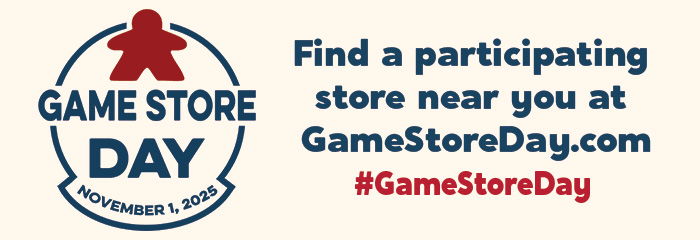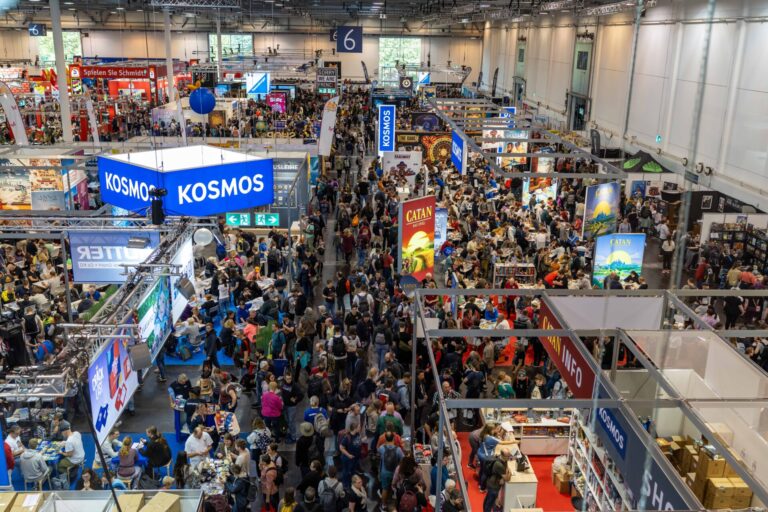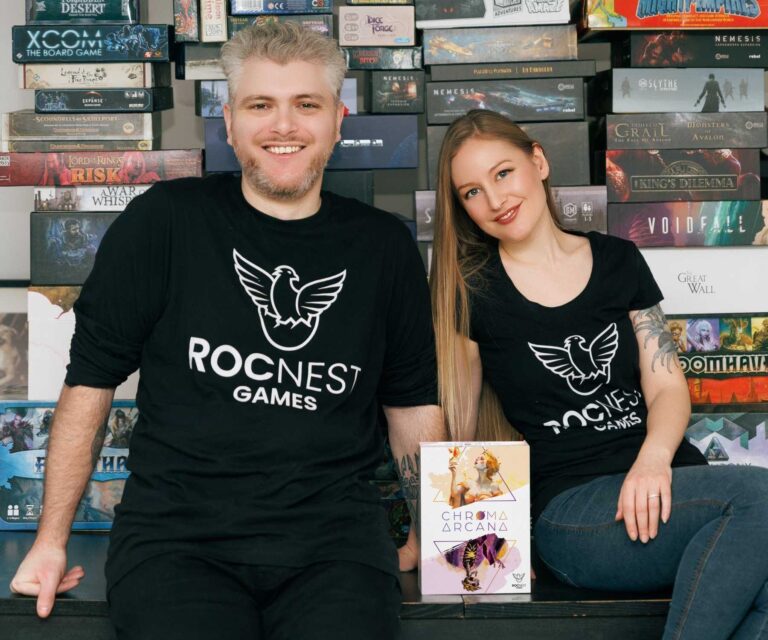
“Board games are about to get more expensive”: Arcane Wonders president Robert Geistlinger on tariffs, razor-thin margins and the math of producing games
The board game industry has been awash with discussion about the potentially crippling effect of tariffs for several months now, with publishers, distributors and manufacturers all scrabbling to prepare for a leap in the cost of importing games to the US. Chief among the issues is the uncertainty surrounding the situation – tariffs of up to 100% on imports from China, where the vast majority of board games are made, were being talked about by then President-elect Donald Trump last November, stoking fears of a “great collapse” of the US board game industry. So far those tariffs have only reached 10%, but ongoing sabre-rattling from Trump and tit-for-tat tariffs on US goods introduced by China have created an unpredictable trading environment. In this article for BoardGameWire, Robert Geistlinger, president of US board game major Arcane Wonders, explains how even a 10% tariff rate will have an outsized effect on publishers already working on razor-thin margins.
Board games are about to get more expensive. I don’t say this as a matter of opinion, but rather the current situation that publishers find themselves in. It is no secret that many board games are manufactured outside of the United States, with most of them produced in China. On February 4, 2025, the current administration implemented a 10% tariff on all products imported from China. This, of course, also includes board games. Once the cost of a product has increased, prices rarely go down later.
Even before I was a publisher, the concern of what potential tariffs might do to board game prices was at the forefront of my mind, both as a gamer who has amassed a hefty collection of games and at the time working in the logistics space of the industry. In 2018, I worked for a fulfillment company when the first round of tariffs took effect on Chinese-made products. Thankfully, at that time, board games were not included in the Harmonized Codes list of products affected. However, this did not stop the question from coming up in meetings with several of my clients about the outcome should that change.
Fast-forward to today, and I am on the publishing side of the industry as president of Arcane Wonders. I am now having to tackle what these new tariffs will mean for my business going forward.
Here’s the not-so-secret little secret of the board game industry – margins are razor-thin for most publishers. To really understand how tariffs affect those margins and, ultimately, the final price a consumer pays at the register, we need to first look at how those margins are applied and how they ultimately set the final cost of the game.
The most important factor that sets a final MSRP (Manufacturer Suggested Retail Price) for any product is the “Landed Cost.” This includes not just the cost to manufacture the game but also the price to ship the games to a warehouse. Imports, duties and even royalties can all factor into this number. This cost is then multiplied to come to an MSRP, with most companies opting to round the number up or down to a 0.99 or 4.99 increment.
Just to give an example: Let’s say my new family-weight game has a manufacturing cost of $10.00, and the freight cost for 10,000 copies of the game adds $1.50 per game in a pre-tariff world, assuming, for the sake of simplicity, no other costs. My Landed Cost would be $11.50 for this game. A reasonable markup number would be x7, so multiply the cost by seven to arrive at $80.50. A publisher will decide how to adjust to an MSRP using this formula. In this case, I would most likely set the MSRP to $79.99 or lower.
Here is the part most of us do not want to admit: many of us are probably pushing those numbers down artificially to not “price our game out of the market”. I have been guilty of this more than a few times myself. That one game might need to cost $79.99 when all the costs are factored in, but I don’t believe that consumers will pay that, so the game gets pushed out at $49.99 or $59.99 instead, making the markup around 4.35 to 5x. Let’s go with $59.99 for the remainder of this example.
Next, we have distribution and retailer margins. The publisher is most likely not selling the game in great quantities directly to consumers but instead to a distributor (or even possibly a consolidator who then sells to a distributor). This is sold at a hefty discount, often around 35% to 40% of the MSRP, depending on the deal the publisher has. Those who use a consolidator before distribution typically receive the lower end of that.
Retailers then buy the games from distributors at another percentage of the MSRP, usually around 50%. Finally, the game is placed on a shelf for the consumer to purchase, hopefully at the MSRP, but this is at the retailer’s discretion in most cases. In our current example, for a game with a Landed Cost of $11.50, I would receive $20.99 for the game as the publisher, assuming the MSRP of $59.99. This game might have been pulled down to $49.99, the lower-end estimation, to make it attractive to the buyer demographic. However, I will assume the price stayed at $59.99.
Pulling out the original Landed Cost, I have $9.49 per game that must cover all the remaining expenses and hopefully leave something for profit; otherwise, the game wouldn’t be worth the years of work that went into it. Royalties, marketing, shipping, employees, operating expenses, and recouping the art, development, and even tooling expenses that went into the game before it ever went to print all need to be covered. Additionally, we’re hoping the game is a success and not a single print run, as there needs to be leftover money to cover a reprint as well!
Without getting too much deeper into the math here, the truth is that the remaining amount won’t cover those expenses in our example. Even if they cover the standard costs, there isn’t any money left for a full reprint. The amount received in distribution for the entire print run is less than the total amount for another 10,000 copies from the manufacturer. The math just doesn’t work.
For any small business to survive, it needs money to cover all expenses plus additional profit for growth and future products. In this example, there isn’t anything left to grow the business. These days, I try to follow a policy of “for every $1 spent, we should receive $2 when sold”. The reality, though, is that I should aim for at least a “$1 spent, $3 returned” stance to grow the business and continue to make new games for people around the world!
Now, let’s go back to tariffs.
Tariffs add to the imports and duties portion and are calculated based on the value of the goods and the cost of the freight. This is a bit of a compounding problem. Freight costs have escalated in the past five years, and it is hard to believe they will ever return to their previous levels. Once the costs have increased, they rarely go down later.
In the example above, a 10% tariff adds an additional $1.50 to the game’s Landed Cost, which doesn’t sound like a lot at first glance, but if you process it through the margins, markups, and profits above, it escalates. At a very basic level, $1.50 in tariff will increase the MSRP between $7.50 and $10.50, depending on the markup used. I expect this to be either a $5 or $10 increase in the real world for the consumer, though.
All told this shouldn’t seem like a drastic increase either, but consumers have pushed back many times when publishers have tried to increase the prices of their games. I am often reminded of a discussion I participated in a while back where a gamer said, “The gameplay in this isn’t worth the price.” While I can understand the feeling of this, the cost of a game isn’t based on the gameplay. It is based on components in the box, and gamers have come to expect higher quality components in even the simplest of hobby board games these days.
Both manufacturing and freight costs have increased over the past five years, while most publishers have tried to absorb many of those costs instead of passing them on. Now, those two costs are getting an instant 10% increase, and most of us don’t have any room left in the already thin profit margins to absorb more. It might not seem like a lot when broken down to a single game, but on a full 10,000 print run, that additional $15,000 in tariffs might be the difference between your favorite publisher being able to make new games or not.
As a gamer myself, I would very much like to continue making new games for people all over the world to enjoy. As someone running a business, I want to do more than keep the lights on. I’d like to grow. There are other options for publishers, such as crowdfunding and direct-to- consumer/retailer sales, but those are not without their own challenges and downsides. Not every game works for crowdfunding, and selling directly will potentially move fewer copies and require additional warehousing and employee overhead costs.
Distribution remains the easiest way for small publishers to reach a larger audience of gamers and retailers. This, however, much like talking about manufacturing outside of China, is a discussion for another day. All of this is to say what should be apparent by now: board games are about to get more expensive. And once the price of something has increased, it rarely goes back down.







[…] began to set in on February 4 when Trump imposed a 10% tariff on Chinese imports – a level already hugely problematic for an industry which traditionally works on razor-thin margins and has to work on a long supply […]
[…] game makers and sellers have been scrambling since February to adjust their businesses after Trump initially imposed a 10% tariff on Chinese imports, which was doubled to 20% at the […]
[…] Arcane Wonders President Robert Geistlinger warned customers in an article for BoardGameWire.com that price increases are […]
[…] game publishers had already warned of inevitable prices increases back in February, when newly-inaugurated US President Donald Trump unveiled a 10% tariff on goods being imported […]